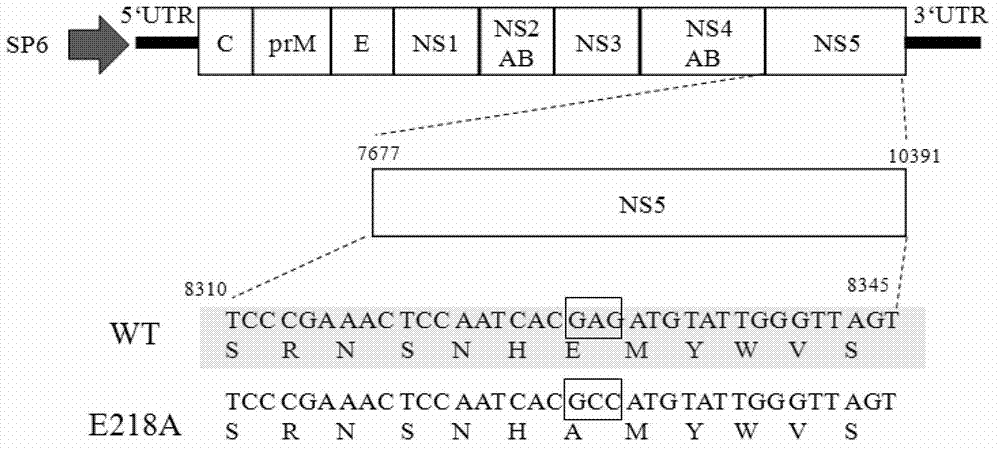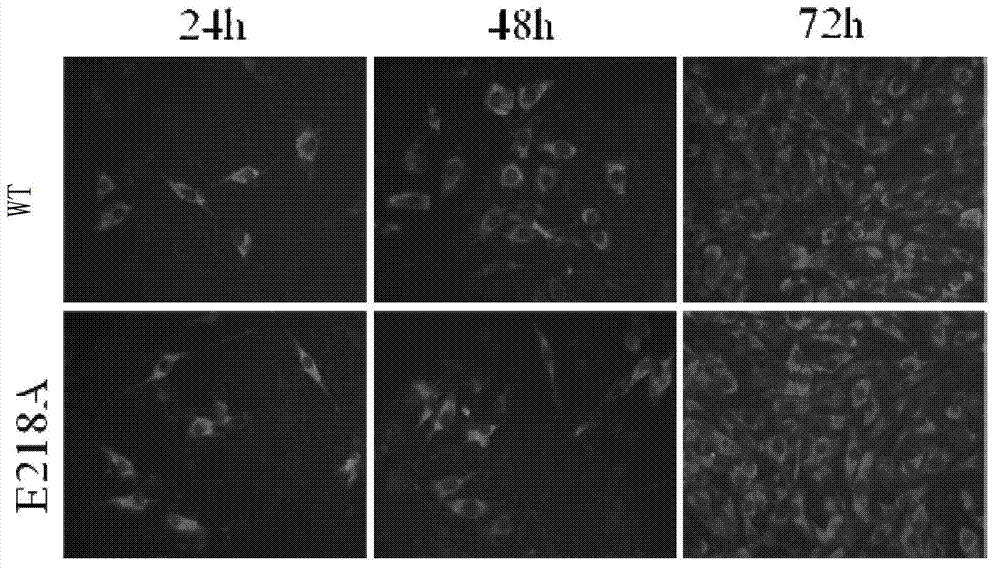Recombinant encephalitis B virus and application thereof
A technology for recombining viruses and proteins, applied in the fields of application, viral peptides, antiviral agents, etc., can solve the problem of no effective treatment for Japanese encephalitis, and achieve good application prospects, low possibility, and high safety Effect
- Summary
- Abstract
- Description
- Claims
- Application Information
AI Technical Summary
Problems solved by technology
Method used
Image
Examples
Embodiment 1
[0034] Embodiment 1, construction and identification of Japanese encephalitis virus E218A
[0035] The purpose of this example is to construct a methyltransferase-deficient recombinant Japanese encephalitis virus (also known as Japanese encephalitis virus E218A, represented by E218A). The schematic diagram of the cDNA structure corresponding to the full-length RNA of the wild-type Japanese encephalitis virus (virulent strain, represented by WT) and the mutation site are shown in figure 1 .
[0036] The cDNA sequence corresponding to the full-length RNA of the wild-type Japanese encephalitis virus (virulent strain) is shown in sequence 1 of the sequence table, from the 1st to the 95th nucleotide of the 5' end is the 5'UTR, the 96th -476th nucleotide is the coding gene of capsid protein C (C), the 477th-2477th nucleotide is the coding gene of prM-E protein (prM-E), and the 2478th-3722nd nucleotide is Nucleotides 3723-4607 of the gene encoding the nonstructural protein NS1 (NS1...
Embodiment 2
[0090] Embodiment 2, the infection rate of Japanese encephalitis virus to BHK-21 cell
[0091] The transcript RNA obtained in step 3 of Example 1 and the transcript RNA obtained in step 2 of 2 were determined as follows:
[0092] 1. Infect monolayer BHK-21 cells with transcript RNA, collect cells at 24, 48, and 72 hours after infection, resuspend in DMEM medium containing 10% FBS, spread on glass slides, and store at 37°C, 5% CO 2 After culturing under the same conditions for 8-12 hours, the antigen sheet was obtained. The antigen sheet was fixed in acetone at -20°C for 30-60 minutes, dried and placed in a refrigerator at -20°C to be sealed for use.
[0093] 2. Using the Japanese encephalitis virus envelope E protein polyclonal antibody (purchased from abcam company, the product catalog number is ab41671), the virus-specific protein in BHK-21 cells was detected by indirect immunofluorescence. The method is as follows: Dilute the antibody in an appropriate ratio, incubate with...
Embodiment 3
[0095] Embodiment 3, the plaque characteristic of Japanese encephalitis virus
[0096] The Japanese encephalitis virus E218A seed liquid prepared in Example 1 and the wild type Japanese encephalitis virus (virulent strain) seed liquid were detected as follows:
[0097] Set the titer to 1 x 10 8 The Japanese encephalitis virus E218A seed solution of PFU / mL was serially diluted 10 times with DMEM medium containing 2% FBS (the dilution was 10 -1 、10 -2 、10 -3 、10 -4 , 10 -5 、10 -6 and 10 -7 ). Set the titer to 4 x 10 8 PFU / mL (virulent strain) of wild-type Japanese encephalitis virus (virulent strain) seed solution was diluted 10-fold with DMEM medium containing 2% FBS (the dilution was 10 in sequence) -1 、10 -2 、10 -3 、10 -4 、10 -5 、10 -6 and 10 -7 ). Inoculate 500 μl / well of each dilution on a monolayer of BHK-21 cells spread on a 6-well plate at 37°C, 5% CO 2 Let stand for 1-2 hours under the conditions, discard the culture supernatant, add agar cover (that is...
PUM
 Login to View More
Login to View More Abstract
Description
Claims
Application Information
 Login to View More
Login to View More - R&D
- Intellectual Property
- Life Sciences
- Materials
- Tech Scout
- Unparalleled Data Quality
- Higher Quality Content
- 60% Fewer Hallucinations
Browse by: Latest US Patents, China's latest patents, Technical Efficacy Thesaurus, Application Domain, Technology Topic, Popular Technical Reports.
© 2025 PatSnap. All rights reserved.Legal|Privacy policy|Modern Slavery Act Transparency Statement|Sitemap|About US| Contact US: help@patsnap.com



